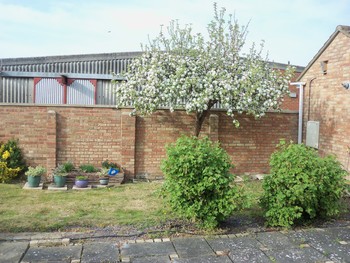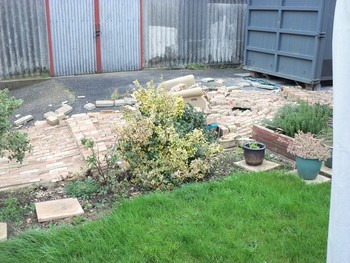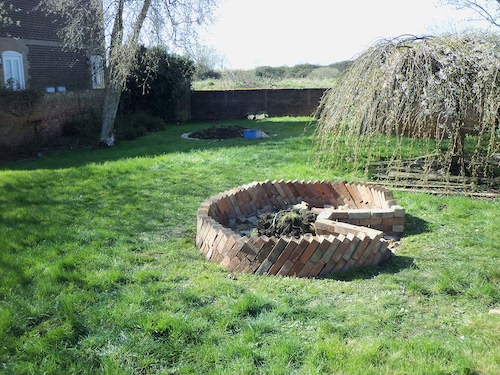|
Previous Entry
First Entry
|
Why, yes, there was wind
A about a month ago (8-9 Feb 2020), Storm Ciara blew through the UK. It caused widespread disruption,
around 450 flood warnings, and gusts of up to 80 mph in some places.
A University of East Anglia meteorologist, said the top recorded gust in Norfolk was 71 mph
at Marham, where there's an RAF base. Marham is less than ten miles from our house.
That's a lot of wind. Enough wind, in fact, to make the picture on the left look like the picture on the right.
(The tree is unharmed, just off camera.)


That's the brick wall on the north side of our garden. We have (well, we had) about
thirty foot of brick, then another sixty or so of wooden fencing. The wooden fencing was old,
beat up, and coming apart. I had repaired bits of it a couple of times already. It was lashed
to trees on the western edge to keep it upright, and was battened to the brick wall on the eastern
edge. It was on our list of things to deal with at some point. When this storm hit, most
of the fence went down hard.
The brick wall was 'single-skin', what is sometimes called 'half-brick thick,' meaning
it was a single row of bricks laid narrow-end on.
As one website notes,
'Safety can also be a big concern for freestanding half-brick walls as they have limited structural support, meaning the higher your wall is, the more unstable it becomes. Heavy winds can wreak havoc and turn your masonry into a pile of rubble!'
(As an aside, that website also indicates that single-skin walls
should not really be taller than about .6 meters, about a third of what we had.)
How right they were. Our wall was six feet tall - nearly two meters.
Given what we learned in the following few days, I'm slightly surprised it
stayed up as long as it did. I'm assuming it was built in 1985 when the rest of the
extension was built, which means it stood for thirty-five years, which I guess is not too bad a run.
It looked pretty, but whomever built it skimped on the quality. Which is a bit of a through line for
a lot of the additions and expansions they put in at that time and over the years.
In any case, this has moved the schedule up for doing something on that side of the
garden. We started out thinking maybe we'd do a brick wall (double-skin!) at around a meter in height, with pillars every six feet or so, and wooden fencing between that to get it up to five or six feet high in total.
That's a lot of brick, though, and brick is not cheap. So my wife started looking at other options. We thought about brick pillars and wood or iron fencing between them, but the more she investigated
the more she began to like the idea of concrete pillars with wood fencing of some sort between them.
From the pictures you can see that to our north is a warehouse, which is not heavily used. (And the
owners of which are very nice and have been very gracious about our slow pace of rubble removal from their drive.) They recently got planning permission to build some homes, but who knows when or if
anything will happen on that front, and they just let it out to a relative, I believe, who needed
more warehouse space. All of which means that we don't really need a six foot brick wall for
privacy or security, since the warehouse is pretty low traffic and anyone who really wants into our back garden could easily hop the brick wall on the south or west sides.
It's mostly cosmetic, so we want something that looks nice, and that won't go down when the next storm blows through. And climate change means another storm will be blowing through.
 Another side effect of all this is that we have a bunch of bricks that used to be a wall lying
around in various states of health and going spare. With no new wall to use them on, and a fence rather than a wall looking like the plan, we began to reconsider our raised bed options. The old
bed had been against the wall, and we could do something similar, although we'd have to remove it
for a while anyway to get the new fence in. Or we could do something else entirely.
Another side effect of all this is that we have a bunch of bricks that used to be a wall lying
around in various states of health and going spare. With no new wall to use them on, and a fence rather than a wall looking like the plan, we began to reconsider our raised bed options. The old
bed had been against the wall, and we could do something similar, although we'd have to remove it
for a while anyway to get the new fence in. Or we could do something else entirely.
I was discussing this with a friend, and she mentioned keyhole raised beds,
and the more I looked at them the more I liked the idea. You can search around yourself if you want details, but the general idea is a
circular bed, with a keyhole or notch, and a compost space in the center.
The compost there should leach nutrients out into the surrounding bed, although some sources suggest that you'll want to rotate out the center compost every few years.
We had a couple of stands of pampas grass in the garden, which we hated, and started removing last summer. That left us with a couple of round areas in the lawn. It looked ideal! The one furthest from the house we simply put a border of bricks around and put in some 'Bee Bombs,' which are a mix of local wildflower seeds and the like to attract bees. The one closer to the house would be the keyhole raised bed.
This past weekend, I got started on that, since the current crisis (not the weather related one, the disease related one), means I had more time at home on Saturday than I usually do ...
The leaning wall design I cribbed from someplace on the web, mostly because I think it looks cool.
The next step will be to take some of the ruined fence planks and make a loose barrel-type structure
in the middle for the compost. More of the wood and brick rubble will form the lower layers
in the bed. On top of that, I'll basically load everything out of the compost bin at the bottom
of the garden, and then on top of that we'll move the herbs from the old raised bed, added more,
fresh compost from the garden store as and when we need it.
Luddite'sLog, 22 March 2020
© 2020 Jeff Berry
|
Next Entry
Last Entry
|
![Smashy the Hammer hates cell phones [Smashy the Hammer]](/hammer.gif)
![Of course there is mouseover text, because, hey, aspiring. [An Aspiring Luddite]](/Luddite2.gif)
![I am looking at my off-camera
bass guitar [Jeff Berry]](/file.jpg)


 Another side effect of all this is that we have a bunch of bricks that used to be a wall lying
around in various states of health and going spare. With no new wall to use them on, and a fence rather than a wall looking like the plan, we began to reconsider our raised bed options. The old
bed had been against the wall, and we could do something similar, although we'd have to remove it
for a while anyway to get the new fence in. Or we could do something else entirely.
Another side effect of all this is that we have a bunch of bricks that used to be a wall lying
around in various states of health and going spare. With no new wall to use them on, and a fence rather than a wall looking like the plan, we began to reconsider our raised bed options. The old
bed had been against the wall, and we could do something similar, although we'd have to remove it
for a while anyway to get the new fence in. Or we could do something else entirely.